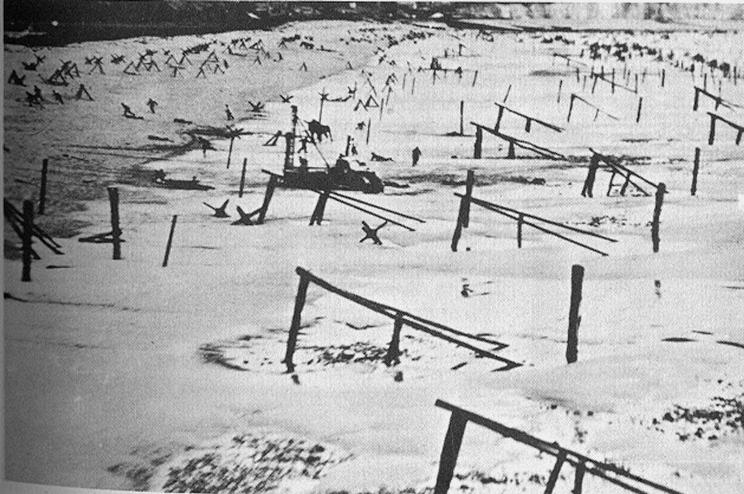“Not so in the West! If the
enemy here succeeds in penetrating our defenses on a wide front, consequences
of staggering proportions will follow within a short time. All signs point to
an offensive against the Western Front of Europe no later than spring, and
perhaps earlier.
For that reason, I can no
longer justify the further weakening of the West in favor of other theaters of
war. I have therefore decided to strengthen the defenses in the West,
particularly at places from which we shall launch our long-range war against
England. For those are the very points at which the enemy must and will attack;
there--unless all indications are misleading--will be fought the decisive
invasion battle.”
Adolf Hitler (Fuhrer Directive 51)
Hitler was well aware that the success of his campaign
hinged upon keeping Europe a one front war. Allied forces invading Western
Europe and creating a second front meant certain disaster for the German
forces. Hitler’s solution was to prevent the Allied forces from crossing the Western
coast of Europe. Hitler sought to create an unbreakable fortification that
spanned from Norway to the border with Spain. He wanted a complex set of heavy
weaponry and pillboxes to be installed at venerable positions along this
coastline. Hitler also order reinforcements to be set up near the front to
provide a quick defense in case the Allied forces were able to push past the
beaches. Hitler wanted to leave the Allies without even the smallest foothold
into Western Europe. This impregnable fortress became known as the Atlantic
Wall.
"It is my unshakeable decision to make this front impregnable
against every enemy"
Adolf Hitler
Hitler placed Erwin Rommel in charge of creating the
Atlantic Wall. After his defeat by Eisenhower in Africa, Rommel was moved into
Europe and ordered to provide motivation for the completion of the Atlantic
Wall by the spring of 1944.

Rommel quickly began fortifying the Atlantic Wall. Rommel’s
goal was to create a complex set of deadly obstacles so that the Allied forces would
not be able to get past the beaches. Rommel knew that if the Allies were able
to secure a landing zone, German defeat was certain. Rommel was a perfectionist
and did not stop adding to the Atlantic Wall until the beaches were a series of
death traps waiting for the Allied soldiers.
Rommel first ordered the beaches of the English Channel to be
mined. From 1941 until 1944 on million
seven hundred thousand mines had been placed haphazardly along the coastline. Rommel
requested that one mine be laid for every ten yards of a one thousand mile wide
section of French coastline. He then made the same request for an eight
thousand mile section of coastline with more mines in areas of strategic
importance, placing in total another forty million mines.

In addition to flooding and mining the French countryside to
prevent paratrooper landings, Rommel created a set of deadly obstacles that the
Allied forces needed to overcome on D-Day. The first set of obstacles was the
Belgium gates. Rommel placed these ten feet tall gate like structures attached
to antitank mines 250 yards from the high water mark. About 20 yards up the
coast sat heavy long tipped with mines drove deep into the sand. The steel
hedgehogs made up the third band of obstacles. The steel rails set at ninety-degree
angles could tear up the bottom of the landing crafts. Should the Allied soldiers navigate these
obstacles and avoid land mines placed irregularly across the beach, they were
met with machine gun fire from the concrete pillboxes. Rommel placed the artillery
so that the entirety of the beach could be covered with gunfire. The soldiers
also had to cross barbed wire and antitank ditches and concrete barriers before
finally reaching the bluffs.
Rommel’s Atlantic Wall was broken on June 6, 1944 and the
Allies were able to establish a secure foothold in Europe. This failure is not
a testament to the inadequacy of Rommel’s fortifications. Rommel’s obstacle
course claimed many Allied soldiers on D-Day. The failure of the Atlantic wall
is rather a testament to the will of the Allied soldiers to defeat the German
forces and liberate Europe.
FOR MORE INFORMATION
“Assault Plan.” U.S. Army
Center of Military History. Last modified October 2002. Accessed February 9,
2014. http://www.history.army.mil/books/wwii/100-11/ch2.htm#Enemy.
“A View From Inside.” The National D-Day Memorial. Accessed
February 9, 2014. http://www.dday.org/history/the-enemy-nazi-germany/a-view-from-inside.
Brooke, Richard S. “Operation
Overlord: The D-Day Landings.” Combined Operations Command. Accessed February
8, 2014. http://www.combinedops.com/Overlord.htm#TheGerman Defences.
“German fortifications: D-Day
on Normandy.” World War 2 Headquarters. Accessed February 8, 2014. http://worldwar2headquarters.com/HTML/normandy/beacheads/germanPillbox.html.
Görlitz, Walter Otto Julius. “Rommel, Erwin: Normandy and
Conspiracy.” Enclyopedia Brittanica’s Guide to Normandy 1944.” Accessed
February 9, 2014. http://www.britannica.com/dday/article-8423.
Laurenceau, Marc. “The Atlantic
Wall in Normandy.” D-Day-Overlord.com. Accessed February 8, 2014. http://www.dday-overlord.com/eng/atlantic_wall.htm.
Williams, Brian. “The Atlantic
Wall.” Military History Online.com. Accessed February 8, 2014. http://www.militaryhistoryonline.com/wwii/dday/prelude.aspx.
No comments:
Post a Comment